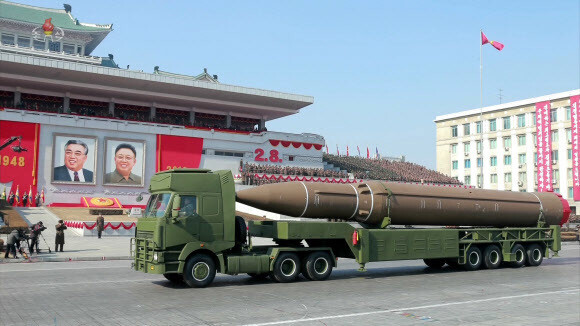hankyoreh
Links to other country sites 다른 나라 사이트 링크
Kim Jong-un refers to “new strategic weapon” while emphasizing economic prosperity

North Korean leader Kim Jong-un’s reference to a “new strategic weapon,” which he said will be seen “in the near future,” came in the context of his statement that “nothing has changed [about the external environment] between the days when we maintained the line of simultaneously pushing forward the economic construction and the building of nuclear force and now when we struggle to direct our efforts to [. . .] economic construction.”
According to Kim, the weapon is designed to counter “increasing [. . .] hostile acts and nuclear threat against us.” Such remarks suggest the weapon is linked to strengthening the North’s nuclear deterrent.
While Kim didn’t lay out a specific timeframe, as he had in his reference to a “Christmas present,” his reiteration about “the near future” indicates that the strategic weapon will be disclosed “in the near future.”
“It won’t take very long to move into action. I don’t it’ll go past next month,” said Yang Moo-jin, professor at the University of North Korean Studies.
Since Christmas passed uneventfully, the US Defense Department has identified Kim Jong-un’s birthday (on Jan. 8) as the next potentially significant date, the Wall Street Journal reported.
The “new strategic weapon,” Kim explained, is “to be possessed” by North Korea, suggesting that it will differ from previously disclosed weapons or will have greatly upgraded capabilities. Experts think that this will be related to the “crucial tests” that the North carried out at Tongchang Village on Dec. 7 and 13.
These tests involved a new two-stage engine using liquid fuel, prompting the theory that the engine would be installed on a multi-warhead intercontinental ballistic missile (ICBM) that the North is seeking to develop. According to this theory, North Korea has upgraded the “Mt. Paektu engine” (which appeared on the Hwasong-15 missile, tested in November 2017), increasing its output to enable the launch of multiple warheads.
“The Mt. Paektu engine was developed hurriedly in order to increase the range of the Hwasong-15. The engine’s first and second stages are likely to be both replaced this time,” said a source in the South Korean military.
A multi-warhead ICBM, which releases several warheads at a target point in the atmosphere, isn’t easy to intercept. The Hwasong-15 is already capable of reaching the American homeland; equipping it with a high-output two-stage engine and multiple warheads would make it a much higher threat.
“The [. . .] new technologies gained in the recent tests [. . .] will be fully applied to the development of another strategic weapon [. . .] for definitely and reliably restraining and overpowering the nuclear threat of the US,” said Pak Jong-chon, chief of the General Staff Department of the Korean People’s Army, in a statement released the day after the second engine test.
The US regards a North Korean ICBM launch as a red line, leading some to predict that North Korea will test the US’ resolve by firing off a submarine-launched ballistic missile (SLBM). This past October, the North fired an SLBM, called Pukkuksong-3, from an underwater launcher, describing the missile as an “underwater strategic ballistic missile.”
This time around, North Korea could launch the missile from an actual submarine or fire an upgraded version carrying multiple warheads. Unveiling a new submarine capable of carrying such missiles would also have strategic significance as a nuclear deterrent, military experts say.
By Yoo Kang-moon, senior staff writer
Please direct comments or questions to [english@hani.co.kr]

Editorial・opinion
![[Column] The state is back — but is it in business? [Column] The state is back — but is it in business?](https://flexible.img.hani.co.kr/flexible/normal/500/300/imgdb/original/2024/0506/8217149564092725.jpg) [Column] The state is back — but is it in business?
[Column] The state is back — but is it in business?![[Column] Life on our Trisolaris [Column] Life on our Trisolaris](https://flexible.img.hani.co.kr/flexible/normal/500/300/imgdb/original/2024/0505/4817148682278544.jpg) [Column] Life on our Trisolaris
[Column] Life on our Trisolaris- [Editorial] Penalties for airing allegations against Korea’s first lady endanger free press
- [Editorial] Yoon must halt procurement of SM-3 interceptor missiles
- [Guest essay] Maybe Korea’s rapid population decline is an opportunity, not a crisis
- [Column] Can Yoon steer diplomacy with Russia, China back on track?
- [Column] Season 2 of special prosecutor probe may be coming to Korea soon
- [Column] Park Geun-hye déjà vu in Yoon Suk-yeol
- [Editorial] New weight of N. Korea’s nuclear threats makes dialogue all the more urgent
- [Guest essay] The real reason Korea’s new right wants to dub Rhee a founding father
Most viewed articles
- 1[Column] Why Korea’s hard right is fated to lose
- 2Amid US-China clash, Korea must remember its failures in the 19th century, advises scholar
- 360% of young Koreans see no need to have kids after marriage
- 4[Column] The state is back — but is it in business?
- 5AI is catching up with humans at a ‘shocking’ rate
- 6Japan says it’s not pressuring Naver to sell Line, but Korean insiders say otherwise
- 7[Column] Can Yoon steer diplomacy with Russia, China back on track?
- 8Hybe-Ador dispute shines light on pervasive issues behind K-pop’s tidy facade
- 9Presidential office warns of veto in response to opposition passing special counsel probe act
- 10Gangnam murderer says he killed “because women have always ignored me”